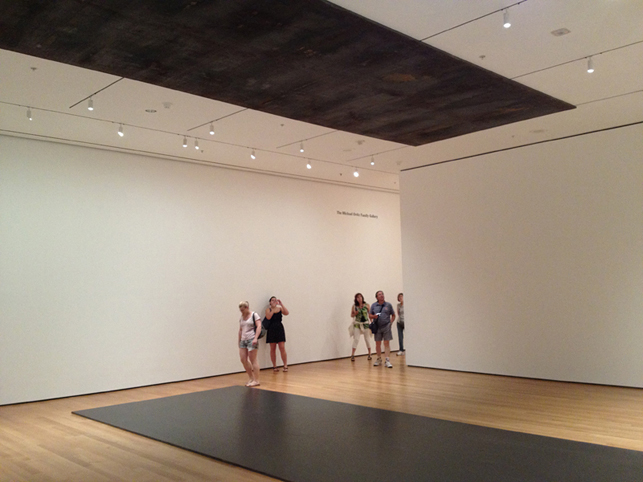 The largest permanent installation at MOMA (Museum of Modern Art) isn’t art. Museum goers on the upper floors walk across a sprawling canvas of wood flooring – or more exactly, 4” tongue and groove engineered (veneer over plywood we’d expect) White Oak. It’s the expected choice, given factors of durability (hard wearing), cost (moderate) and aesthetics (a clear even grain that won’t divert from the art). Oak is like the gallery white wall, underfoot. But was it the best or only choice? Flooring specialists across different materials may call for a range of choices. But the natural warmth of wood, it’s ability to be both traditional and modern, and it’s abundance (at least with Oak, a relatively sustainable species), is part of why the wood product was specified. Would reclaimed wood be appropriate? Flooring grades with any degree of character marks – nail holes, knots, stress cracks, not to mention the currently popular “Dirty Top” (retaining the weathered surface of the wood), may raise some objections within the museum board and others. But a clear vertical grain heart Pine, a select grade of reclaimed Oak, or Ipe from the city boardwalks (another major American museum is considering the salvaged woods from the Coney Island boardwalk) may have been acceptable, potentially bringing a slightly richer hue and just enough character to connect with the art without diverting museum goers. The boards debate could then turn to getting the new installation under budget. Photo: Suzanne DeChillo/The New York Times
The largest permanent installation at MOMA (Museum of Modern Art) isn’t art. Museum goers on the upper floors walk across a sprawling canvas of wood flooring – or more exactly, 4” tongue and groove engineered (veneer over plywood we’d expect) White Oak. It’s the expected choice, given factors of durability (hard wearing), cost (moderate) and aesthetics (a clear even grain that won’t divert from the art). Oak is like the gallery white wall, underfoot. But was it the best or only choice? Flooring specialists across different materials may call for a range of choices. But the natural warmth of wood, it’s ability to be both traditional and modern, and it’s abundance (at least with Oak, a relatively sustainable species), is part of why the wood product was specified. Would reclaimed wood be appropriate? Flooring grades with any degree of character marks – nail holes, knots, stress cracks, not to mention the currently popular “Dirty Top” (retaining the weathered surface of the wood), may raise some objections within the museum board and others. But a clear vertical grain heart Pine, a select grade of reclaimed Oak, or Ipe from the city boardwalks (another major American museum is considering the salvaged woods from the Coney Island boardwalk) may have been acceptable, potentially bringing a slightly richer hue and just enough character to connect with the art without diverting museum goers. The boards debate could then turn to getting the new installation under budget. Photo: Suzanne DeChillo/The New York Times
Reclaimed Wood:a Field Guide
The first complete visual survey of this valuable resource, with chapters on history, sources and types of wood, reclamation and practical information, and contemporary uses in residential and commercial projects.

Join our newsletter and get updated!
Get occasional updates on what is going on within our company and activites.

Our location at 71 Troy Avenue in Brooklyn includes a showroom, and a 3600 sf warehouse and wood shop. We are currently open for meetings by appointment. The space features a broad selection of over 40 antique, vintage and rare reclaimed woods.
Brooklyn warehouse & showroom
(917) 862 7910
info@sawkill.nyc
Mon.-Fri. 9:00 – 5:30 pm
Sat. 10-4pm
1 Troy Ave.
Brooklyn, NY 11213
Please call in advance for appointment!
Getting There:
Train: A, C to Utica Ave. train stop. (approx. 8 min walk)
Car: Atlantic Ave. to Troy Ave. (1.5 mi. from Barclay Center)
